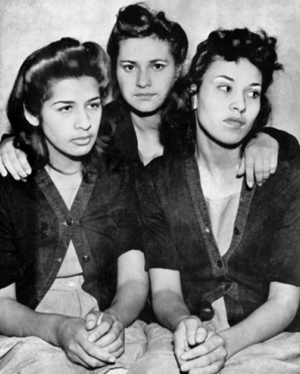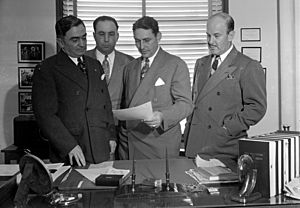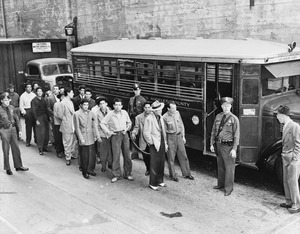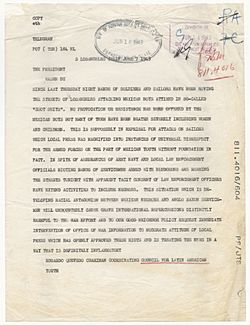Zoot Suit Riots facts for kids
Quick facts for kids Zoot Suit Riots |
|
|---|---|
| Location | Los Angeles, California, United States |
| Date | June 3–8, 1943 |
| Target | Mexican-Americans youths and other Zoot suit wearers |
|
Non-fatal injuries
|
150+ |
| Victims | 500+ arrested |
| Assailants | American servicemen, police officers, and white civilians |
| Motive | Racism, removal of zoot suits and "hoodlums" |
The Zoot Suit Riots were a series of riots on June 3–8, 1943 in Los Angeles, California, United States, involving American servicemen stationed in Southern California and young Latino and Mexican American city residents. It was one of the dozen wartime industrial cities that suffered race-related riots in the summer of 1943, along with Mobile, Alabama; Beaumont, Texas; Detroit, Michigan; and New York City.
American servicemen and white Angelenos attacked and stripped teenagers and youths who wore zoot suits, ostensibly because they considered the outfits, which were made from large amounts of fabric, to be unpatriotic during World War II. Rationing of fabrics and certain foods was required at the time for the war effort. While most of the violence was directed toward Mexican American youth, African American and Filipino American youths who were wearing zoot suits were also attacked.
The riot appeared to trigger similar attacks that year against Latinos in Chicago, San Diego, Oakland, Evansville, Philadelphia, and New York City. The defiance of zoot suiters became inspirational for Chicanos during the Chicano Movement.
Contents
Background
Mexicans in Los Angeles
California was a part of Mexico for 27 years, before becoming part of the United States. Due to this history, there has always been a large Latino population in California. During the early 20th century, many Mexicans immigrated for work to US border states which needed workers, areas such as Texas, Arizona, and California. They were recruited by farmers for work on the large farms and also worked in those states in non-agricultural jobs.
During the Great Depression, in the early 1930s, the United States deported between 500,000 and 2 million people of Mexican descent (including the illegal expulsion of up to 1.2 million U.S. citizens) to Mexico (see Mexican Repatriation), in order to reduce demands on limited American economic resources. By the late 1930s, about three million Mexican Americans resided in the United States. Los Angeles had the highest concentration of ethnic Mexicans outside Mexico.
Job discrimination in Los Angeles forced minorities to work for below-poverty level wages. The Los Angeles newspapers described Mexicans with racially inflammatory propaganda, suggesting a problem with juvenile delinquency. These factors caused much racial tension between Mexican immigrants, those of Mexican descent, and European Americans.
During this time, Los Angeles was undergoing an expansion, which caused disruptions in communal sites, family sites, and family patterns of social interactions due to poor city planning. One major decision was to put a million-dollar Naval training school for the Naval Reserve Armory in the Chavez Ravine, a primarily working-class and immigrant area for Mexican-Americans. As young Mexican-American men from the neighborhood began attacking the ideals of white privilege through a campaign of harassment, intimidation, and resistance a year prior to the riots, the Chavez Ravine area would later be a hot spot for encounters between the zoot suiters and sailors.
Lalo Guerrero became known as the father of Chicano music, as young people adopted music, language, and dress of their own. Young men wore zoot suits—a flamboyant long jacket with baggy pegged pants, sometimes accessorized with a pork pie hat, a long watch chain, and thick-soled shoes. They called themselves "pachucos". In the early 1940s, arrests of Mexican-American youths and negative stories in the Los Angeles Times fueled a perception that these pachuco gangs were delinquents who were a threat to the broader community.
The police and press characterized all Mexican youths as "pachuco hoodlums and baby gangsters".
World War II
With the entry of the United States into World War II in December 1941 following the Japanese attack on Pearl Harbor, the nation had to deal with the restrictions of rationing and the prospects of conscription. In March 1942, the War Production Board (WPB) regulated the manufacture of men's suits and all clothing that contained wool. To achieve a 26% cut-back in the use of fabrics, the WPB issued regulations for the manufacture of what Esquire magazine called, "streamlined suits by Uncle Sam". The regulations effectively forbade the manufacture of the wide-cut zoot suits and full women's skirts or dresses. Most legitimate tailoring companies ceased to manufacture or advertise any suits that fell outside the War Production Board's guidelines. But the demand for zoot suits did not decline; a network of bootleg tailors based in Los Angeles and New York City continued to produce the garments. Youths also continued to wear clothes which they already owned.
Meanwhile, American soldiers, sailors, and Marines from across the country travelled to Los Angeles in large numbers as part of the war effort; they were given leave while awaiting to be shipped out to the Pacific theater. Servicemen and zoot suiters in Los Angeles were both immediately identifiable by their dress. Some servicemen and others in the community felt that the continued wearing of zoot suits represented the youths' public flouting of rationing regulations. Officials began to cast wearing of zoot suits in moral terms and associated it with the commission of petty crime, violence and the snubbing of national wartime rules. In 1943, many servicemen resented the sight of young Latinos wearing zoot suits after clothing restrictions had been published, especially as most came from areas of the country with little experience or knowledge of Mexican-American culture. Although Mexican-Americans were overrepresented in the armed forces, they were not common or respected enough to defuse these tensions.
Zoot suits
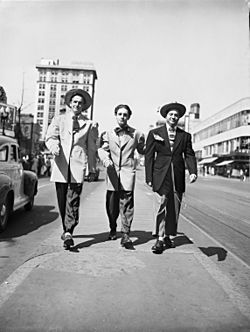
Zoot suit fashion found its origins in the urban black scene during the 1940s. This style of clothing cultivated a sense of racial pride and significance; however, the fashion statement soon made its way into the wardrobes of young Southern Californian Mexican Americans, Italians and Filipinos, who became the quintessential wearers of the zoot suit. The transfer and sharing of the zoot suit fashion indicated a growing influence of African American popular culture on young Mexican American, Italian American and Filipino Americans. Additionally, “analysis of the Los Angeles zoot-suit riot and journalists' and politicians' in and the outfit's connections with race relations, slang, jazz music and dance permit an understanding of the politics and social significance of what is trivial in itself -- popular culture and its attendant styles”.
The zoot suit was originally a statement about creating a new wave of music and dress, but it also held significant political meaning. The flamboyant and colorful material indicated a desire to express oneself against the boring and somber slum lifestyle. The zoot suit provided young African American and Mexican youth a sense of individualistic identity within their cultures and society as they discovered “highly charged emotional and symbolic meaning” through the movement, music, and dress.
The zoot suit typically included bright colored fabric, long suit coats that often reached the knees, wide shoulders, and gathered or tapered pants. The arm and ankle areas were often much tighter than the rest of the fabric, giving the whole look a triangular shape.
Often the suit was paired with accessories such as chains and leather soled-shoes, which were typically worn to exaggerate and prove a point of rebellion standing against the wealth and status that many of these youth were unable to access due to their economic and racial identities.
Pachucas and Chicanas
The urban, Mexican-American youth often called themselves "pachucos". The female parallels were called "pachucas" and wore tight sweaters and relatively full, flared skirts, often paired with high hair-dos, large earrings, and heavy makeup. Many young Mexican-American women who were not pachucas avoided these clothing styles and hairstyles in order to avoid being seen as troublemakers by white people. Pachucas formed their own gangs, joined the male pachuco gangs, and carried weapons.
Riots
U.S. service personnel got into violent altercations with young Mexican Americans in zoot suits in San Jose, Oakland, San Diego, Delano, Los Angeles, and smaller cities and towns in California. During this period, the immense war buildup attracted tens of thousands of new workers to factories and shipyards in the West Coast, including African Americans from the South in the second wave of the Great Migration.
The most serious ethnic conflicts erupted in Los Angeles.
The local press lauded the attacks, describing them as having a "cleansing effect" to rid Los Angeles of "miscreants" and "hoodlums". The Los Angeles City Council approved a resolution criminalizing the wearing of "zoot suits with reat [sic] pleats within the city limits of LA" with the expectation that Mayor Fletcher Bowron would sign it into law. Councilman Norris Nelson had stated, "The zoot suit has become a badge of hoodlumism." No ordinance was approved by the City Council or signed into law by the Mayor, but the council encouraged the WPB to take steps "to curb illegal production of men's clothing in violation of WPB limitation orders". While the mobs had first targeted only pachucos, they also attacked African Americans in zoot suits who lived in the Central Avenue corridor area. The Navy and Marine Corps command staffs intervened on June 8 to reduce the attacks, confining sailors and Marines to barracks and ordering that Los Angeles be declared off-limits to all military personnel; this was enforced by Navy Shore Patrol personnel. Their official position was that their men were acting in self-defense.
Reactions
As the riots subsided, the most urgent concern of officials was relations with Mexico, as the economy of Southern California relied on the importation of cheap Mexican labor to assist in the harvesting of California crops. After the Mexican Embassy lodged a formal protest with the State Department, Governor Earl Warren of California ordered the creation of the McGucken Committee (headed by Los Angeles bishop Joseph McGucken) to investigate and determine the cause of the riots. In 1943, the committee issued its report; it determined racism to be a central cause of the riots, further stating that it was "an aggravating practice (of the media) to link the phrase zoot suit with the report of a crime". The governor appointed the Peace Officers Committee on Civil Disturbances, chaired by Robert W. Kenny, president of the National Lawyers Guild to make recommendations to the police. Human relations committees were appointed, and police departments were required to train their officers to treat all citizens equally. Mayor Fletcher Bowron downplayed the role racial prejudice played in the riots and blamed Mexican youth gangs.
On June 16, 1943, a week after the riots, First Lady Eleanor Roosevelt commented on the riots in her newspaper column. "The question goes deeper than just suits. It is a racial protest. I have been worried for a long time about the Mexican racial situation. It is a problem with roots going a long way back, and we do not always face these problems as we should." The Los Angeles Times published an editorial the next day expressing outrage: it accused Mrs. Roosevelt of having communist leanings and stirring "race discord".
On June 21, 1943, the State Un-American Activities Committee, under state senator Jack Tenney, arrived in Los Angeles with orders to "determine whether the present Zoot Suit Riots were sponsored by Nazi agencies attempting to spread disunity between the United States and Latin-American countries". Although Tenney claimed he had evidence the riots were "[A]xis-sponsored", no evidence was ever presented to support this claim.
Later scholars generally characterize the Zoot Suit riots as a "pogrom against the Mexican American community". Many post-war civil rights activists and authors, such as Luis Valdez, Ralph Ellison, and Richard Wright, have said they were inspired by the Zoot Suit Riots. Cesar Chavez and Malcolm X were both zoot suiters as young men and later became political activists.
See also
 In Spanish: Disturbios del Zoot Suit para niños
In Spanish: Disturbios del Zoot Suit para niños


